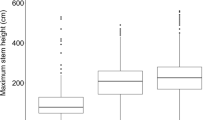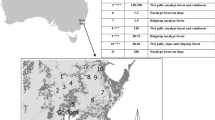Abstract
The fragmentation of mediterranean climate landscapes where fire is an important landscape process may lead to unsuitable fire regimes for many species, particularly rare species that occur as small isolated populations. We investigate the influence of fire interval on the persistence of population fragments of the endangered shrub Verticordia fimbrilepis Turcz. subsp. fimbrilepis in mediterranean climate south-west of Western Australia. We studied the population biology of the species over 5 years. While the species does recruit sporadically without fire this occurs only in years with above average rainfall, so fire seems to be the main environmental factor producing extensive recruitment. Transition matrix models were constructed to describe the shrub’s population dynamics. As the species is killed by fire and relies on a seed bank stimulated to germinate by smoke, stochastic simulations to compare different fire frequencies on population viability were completed. Extinction risk increased with increasing average fire interval. Initial population size was also important, with the lowest extinction risk in the largest population. For populations in small reserves where fire is generally excluded, inevitable plant senescence will lead to local extirpation unless fires of suitable frequency can be used to stimulate regeneration. While a suitable fire regime reduces extinction risk small populations are still prone to extinction due to stochastic influences, and this will be exacerbated by a projected drying climate increasing rates of adult mortality and also seedling mortality in the post-fire environment.






Similar content being viewed by others
References
Abbott I (2003) Aboriginal fire regimes in south-west Western Australia: evidence from historical documents. In: Abbott I, Burrows N (eds) Fire in ecosystems of south-west Western Australia: impacts and management. Backhuys Publishers, Leiden, pp 119–146
Akçakaya HR (2005) RAMAS Metapop: viability and analysis for stage-structured meta-populations (version 5). Applied Biomathematics, Setauket, New York
Akçakaya HR, Burgman MA, Kindvall O, Wood CC, Sjogren-Gulve P, Hatfield JS, McCarthy MA (2004) Species conservation and management: case studies. Oxford University Press, Oxford
Bates BC, Hope P, Ryan B, Smith I, Charles S (2008) Key findings from the Indian Ocean Climate Initiative and their impact on policy development in Australia. Clim Change 89:339–354
Bond WJ, van Wilgen BW (1996) Fire and plants. Chapman and Hall, London
Brown JM, Hopkins AJM (1983) The kwongan (sclerophyllous shrublands) of Tutanning Nature Reserve, Western Australia. Aust J Ecol 8:63–73
Bureau of Meteorology (2003) What is the weather usually like? Averages for Western Australian sites. Available from www.bom.ov.au/climate/averages/tables/ca_wa_names.shtml. Accessed April 2003
Burgman MA (2004) Strategies for plant population viability modelling: an overview. In: Akçacaya HR, Burgman MA, Kindvall O, Wood CC, Sjogren-Gulve P, Hatfield JS, McCarthy MA (eds) Species conservation and management: case studies. Oxford University Press, Oxford, pp 17–22
Burgman MA, Lamont BB (1992) A stochastic model for the viability of Banksia cuneata populations: environmental, demographic and genetic effects. J Appl Ecol 29:719–727
Burgman MA, Keith D, Hopper SD, Widyatmoko D, Drill C (2007) Threat syndromes and conservation of the Australian flora. Biol Conserv 134:73–82
Burne HM, Yates CJ, Ladd PG (2003) Comparative population structure and reproductive biology of the critically endangered shrub Grevillea althoferorum and two closely related congeners. Biol Conserv 114:53–65
Cary GJ, Morrison DA (1995) Effects of fire frequency on plant species composition of sandstone communities in the Sydney region: combinations of inter-fire intervals. Aust J Ecol 20:418–426
Caswell H (2001) Matrix population models construction, analysis and interpretation. Sinauer, Sunderland, Massachusetts
Coates DJ, Atkins KA (2001) Priority setting and the conservation of Western Australia’s diverse and highly endemic flora. Biol Conserv 97:252–263
CSIRO (2007) Climate change in Australia—Technical Report 2007. CSIRO, Bureau of Meteorology, Melbourne, Australia
Drechsler M (2004) Banksia goodii in Western Australia: interacting effect of fire, reproduction, and plant growth on viability. In: Akçacaya HR, Burgman MA, Kindvall O, Wood CC, Sjogren-Gulve P, Hatfield JS, McCarthy MA (eds) Species conservation and management: case studies. Oxford University Press, Oxford, pp 64–74
Enright NJ, Marsula R, Lamont BB, Wissell C (1998a) The ecological significance of canopy seed storage in fire prone environments: a model for non-sprouting shrubs. J Ecol 86:946–959
Enright NJ, Marsula R, Lamont BB, Wissell C (1998b) The ecological significance of canopy seed storage in fire prone environments: a model for resprouting shrubs. J Ecol 86:960–973
George EA (2002) Verticordia the turner of hearts. Benchmark Publications, Melbourne
Hobbs RJ (2002) Fire regimes and their effects in Australian temperate woodlands. In: Bradstock RA, Williams JE, Gill AM (eds) Flammable Australia: the fire regimes and biodiversity of a continent. Cambridge University Press, Cambridge, pp 305–326
Hobbs RJ, Atkins L (1991) Interactions between annuals and woody perennials in a Western Australian nature reserve. J Veg Sci 2:643–654
IOCI (2005) How our rainfall has changed—the south-west. Climate note 5/05 (August) http://www.ioci.org.au/publications/pdf/IOCIclimatenotes_5.pdf
Kaye TN, Pendergrass KL, Finley K, Kauffman JB (2001) The effect of fire on the population viability of an endangered prairie plant. Ecol Appl 11:1366–1380
Keith DA (1996) Fire-driven extinction of plant populations: a synthesis of theory and review of evidence from Australian vegetation. Proc Linnean Soc NSW 116:37–78
Keith DA (2004) Australian heath shrub (Epacris barbata): viability under management options for fire and disease. In: Akçacaya HR, Burgman MA, Kindvall O, Wood CC, Sjogren-Gulve P, Hatfield JS, McCarthy MA (eds) Species conservation and management: case studies. Oxford University Press, Oxford, pp 90–103
Keith DA, McCaw WL, Whelan RJ (2002) Fire regimes in Australian heathlands and their effects on plants and animals. In: Bradstock RA, Williams JE, Gill AM (eds) Flammable Australia: the fire regimes and biodiversity of a continent. Cambridge University Press, Cambridge, pp 199–237
Lamont BB, Connell S, Bergl SM (1991) Population and seed bank dynamics of Banksia cuneata: the role of time, fire and moisture. Bot Gaz 152:114–122
Lefkovitch LP (1965) The study of population growth in organisms grouped by stages. Biometrics 21:1–18
Lloret F, Pausas JG, Vila M (2003) Responses of Mediterranean plant species to differing fire frequencies in Garraf Natural Park (Catalonia, Spain): field observations and modelling predictions. Plant Ecol 167:223–235
Maschinski J, Baggs JE, Quintana-Ascencio PF, Menges ES (2006) Using population viability analysis to predict the effects of climatic change on the extinction risk of an endangered limestone endemic shrub, Arizona cliffrose. Conserv Biol 20:218–228
McCarthy MA, Thompson C (2001) Expected minimum population size as a measure of threat. Anim Conserv 4:351–355
McCaw L, Hanstrum B (2003) Fire environment of Mediterranean south-west Western Australia. In: Abbott I, Burrows N (eds) Fire in ecosystems of south-west Western Australia: impacts and management. Backhuys Publishers, Leiden, pp 87–106
Menges ES (2000) Population viability and analyses in plants: challenges and opportunities. Trends Ecol Evol 15:51–56
Menges ES, Dolan RW (1998) Demographic viability of populations of Silene regia in Midwestern prairies: relationships with fire management, genetic variation, geographic location, population size and isolation. J Ecol 86:63–78
Menges ES, Quintana-Ascencio PF (2004) Population viability with fire in Eryngium cuneifolium: deciphering a decade of demographic data. Ecol Monogr 74:79–99
Moretti M, Conedera M, Moresi R, Guisan A (2006) Modelling the influence of change in fire regime on the local distribution of a Mediterranean pyrophytic plant species (Cistus salvifolius) at its northern range limit. J Biogeogr 33:1492–1502
Moretti M, Staehli C, Gillet F (2008) Determinants for the conservation of a vulnerable fire-dependent species at its marginal range. Plant Ecol 199:89–98
Nield AP, Ladd PG, Yates CJ (2009) Reproductive biology, post-fire succession dynamics and population viability analysis of the Critically Endangered Western Australian shrub Calytrix breviseta subsp breviseta (Myrtaceae). Aust J Bot 57:451–464
Pfab MF, Witkowski ETF (2000) A simple population viability analysis of the critically endangered Euphorbia clivicola (RA. Dyer) under four management scenarios. Biol Conserv 96:263–270
Quintana-Ascencio PF, Menges ES, Weekley CW (2003) A fire-explicit population viability analysis of Hypericum cumulicola in Florida rosemary scrub. Conserv Biol 17:433–449
Regan HM, Auld TD (2004) Australian shrub Grevillea caleyi: recovery through management of fire and predation. In: Akçacaya HR, Burgman MA, Kindvall O, Wood CC, Sjogren-Gulve P, Hatfield JS, McCarthy MA (eds) Species conservation and management: case studies. Oxford University Press, Oxford, pp 23–35
Yates CJ, Broadhurst LM (2002) Assessing limitations on population growth in two critically endangered Acacia taxa. Biol Conserv 108:13–26
Yates CJ, Ladd PG (2005) Relative importance of reproductive biology and establishment ecology for persistence of a rare shrub in a fragmented landscape. Conserv Biol 19:239–249
Yates CJ, Hobbs RJ, Bell RW (1994) Landscape-scale disturbances and regeneration in semi-arid woodlands of south-western Australia. Pac Conserv Biol 1:214–221
Yates CJ, Abbott I, Hopper SD, Coates DJ (2004) Fire as a determinant of rarity in the south-west Western Australian global biodiversity hotspot. In: Abbott I, Burrows N (eds) Fire in ecosystems of south-west Western Australia: impacts and management. Backhuys Publishers, Leiden, pp 395–420
Yates CJ, Ladd PG, Coates DJ, McArthur S (2007) Hierarchies of cause: understanding rarity in an endemic shrub Verticordia staminosa (Myrtaceae) with a highly restricted distribution. Aust J Bot 55:194–205
Acknowledgments
Thanks to Jason Schmidberger, Richard Fairman, Rebecca Dillon for assistance with fieldwork. The Australian Bush Heritage fund for support. This study was conducted with the assistance of a grant from the Commonwealth of Australia Natural Heritage Trust (Endangered Species Program).
Author information
Authors and Affiliations
Corresponding author
Appendix
Appendix
See Tables 3, 4, 5, 6, 7, and 8.
Rights and permissions
About this article
Cite this article
Yates, C.J., Ladd, P.G. Using population viability analysis to predict the effect of fire on the extinction risk of an endangered shrub Verticordia fimbrilepis subsp. fimbrilepis in a fragmented landscape. Plant Ecol 211, 305–319 (2010). https://doi.org/10.1007/s11258-010-9791-0
Received:
Accepted:
Published:
Issue Date:
DOI: https://doi.org/10.1007/s11258-010-9791-0




